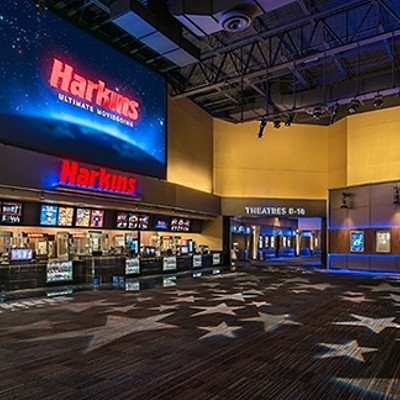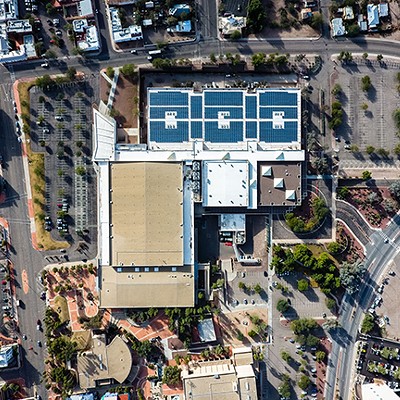At first glance, this seems a fragile construct: After centuries of habitation by everyone from Hohokams and Mexicans to gringo cowboys, Canoa shows its age. A scattering of peeling adobe buildings, a sprawling and boarded-up ranch house, corrals and rambling porches--all surrounded by security fence--it remains a caged vanguard against the indignities of encroaching stucco development.
Canoa came into county hands in the late 1990s, after a brutal zoning fight with Fairfield Homes, a longtime builder best known as the progenitor of Green Valley's much-vaunted grin. When the dust cleared, Pima County ended up with a good chunk of the Canoa property and pledged to scrape together $6.6 million to purchase the rest.
But today, Canoa Ranch stands at a crossroads, poised with potential, yet vulnerable to political dabbling and competing visions.
Both Stone and Kurtz are members of the Canoa Ranch Community Trust/Oversight Committee--Stone is chairwoman--and they're hanging their hopes on $3 million earmarked for rehabbing the ranch. That money is contained in the county bond that goes before voters next spring. "But what we need most right now is a master plan for the entire property," says Stone. "This ranch has prehistoric sites, Western history, wildlife and an environment that needs protection."
Among their greatest worries is that Canoa could end up as a typical county-park patchwork of baseball fields, playgrounds and carp fishing. "We want it to be left as an open area, to retain the historic ambience," Kurtz says. And according to Stone, County Supervisor Ray Carroll has sparked discussions with the Smithsonian Institution, which would consider lending its name and a passel of artifacts to a ranch museum.
But another committee member is worried that the group's input is being sidelined, as the county considers fashioning the ranch into a cash cow. Gerry Juliani says county officials have presented the committee with plans that include turning the ranch house into a restaurant, transforming some of the other old buildings into B&Bs, "and putting in a little museum that's the size of my living room. We were stunned when we heard that. It's so far from our original plan."
That original plan involves "turning the ranch buildings into a museum of the West," he says. "It could be a hell of a tourist draw." Committee members would also like to see the old ranch pond restored, with some of Canoa's expansive floodplain set aside for informal stargazing, "a place where families could go out with their bedrolls, something real simple," Juliani says.
But what really bugs Juliani is a visit to a committee meeting last spring by Rafael Payan, director of the Pima County Natural Resources, Parks and Recreation Department. According to Juliani, Payan told the committee that they should direct their concerns through his department rather than going directly to various county supervisors. "I got the definite feeling," Juliani says, "that the county staff wants us to go away."
Payan was on vacation and unavailable for comment at press time. But Linda Mayro, the county's cultural resources manager, says she doesn't know "why Gerry is making those claims." She adds that the oversight committee is merely an advisory body, and "perhaps they misunderstood their role to be that of an managing entity, which they are not." Either way, she says, "they are not the only voice" in deciding how Canoa is developed.
But Juliani argues that when the committee was created in 2001, it was given oversight of $200,000 that Fairfield Homes was kicking into ranch preservation as part of the county deal. "That fiduciary responsibility puts the committee in a special category," he says, "that goes beyond just (an) advisory role."
For his part, Supervisor Carroll says committee members can bend his ear anytime they please, and to suggest otherwise "must have been a misinterpretation. I don't think there should ever be censorship of a committee through a department."
Regardless of who complains to whom about what, both Stone and Kurtz give Linda Mayro high marks for her efforts on the ranch's behalf. Mayro says that, despite appearances, Canoa has not been ignored. About $1.5 million has already been spent on stabilizing the buildings and creating designs for floodwalls.
"We cannot invest a lot of money in these buildings until there is flood protection, because virtually every building is in the flood plain, and the committee has been apprised of all these things from day one," she says.
Mayro says the county is committed to developing the ranch with a firm eye toward history. But she says the county must also look towards grooming the property to help pay for its upkeep.
"We are doing the architectural assessments in anticipation of starting a public process to identify the best adaptive uses for these buildings," she says. "And a museum has never been discounted. But that may not be the only function.
"There is a lot of interest in things such as a star-gazing camp, living history," she continues. "There's certainly been talk of revenue generation, whether it's a gift shop or a gallery. I know many members are opposed to this. But frankly, to run this kind of operation, it's going to take some revenue coming in, and there needs to be some accommodation of that. If we don't have a sound business plan, I think this project is going to fall on its face."
Meanwhile, back at the ranch, Sandra Stone and Ellie Kurtz are peering into the weathered corral, its ramparts faded to a dirty brown. But to the women, there's no question that Canoa--and the historical pageant it represents--should come back to life.
"Too many people have no sense of what this land really stands for," says Stone, "what it was, and why it's so important to protect it and not just fill it up with houses."
That gets a sardonic chuckle from Kurtz. "I know people in Green Valley and Arivaca," she says, "who think that history began when they arrived."












